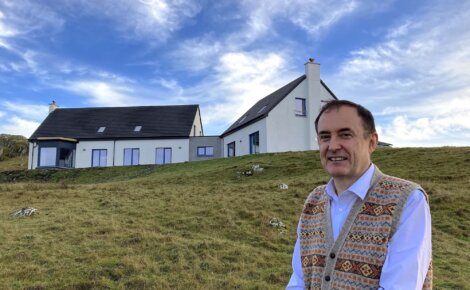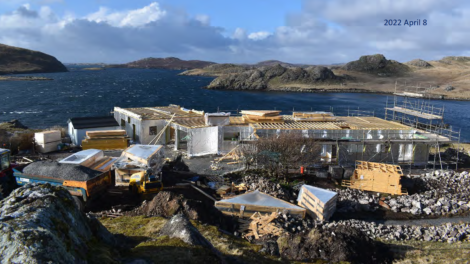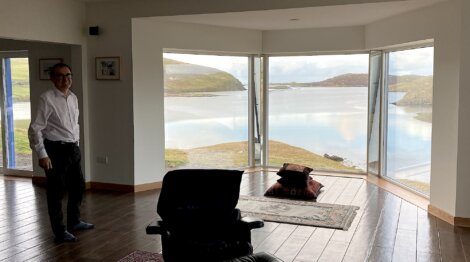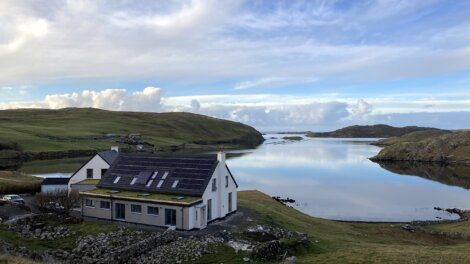Energy / ‘We must build better’ architect says as he moves into new Passive House
WITH energy costs set to stay high for the foreseeable future, one way of combatting Shetland’s high levels of fuel poverty is to ‘build better’ houses, according to local architect Allen Duncan.
And to prove the point, he has just moved into his newly built ‘Passivhaus Plus’ near Clousta, a building that produces more energy than it requires to stay comfortably warm.
Any excess energy will be fed into the local grid once the moratorium on doing so is lifted, which is expected next year when Shetland will be connected to the national grid.
The very spacious and extremely well-insulated timber frame building sits on an exposed north facing site with spectacular views over the Voe of Clousta which can be admired through a series of large windows.
Duncan, originally from Lerwick, has spent the last seven years determined to show that not just Passive House but ‘Passivhaus Plus’ standards are possible and affordable even on a site with very little sun light in winter and at 60 degrees north.
His new home at Skeotaing has just become only the 8th fully certified Passivhaus Plus in the UK and number 156th in the world.
“I wanted to build a comfortable low energy, easy to maintain house that would be a demonstration that the Passivhaus standards can work even up north in the Shetland Islands,” the 67-year-old said.
Duncan has been working as an urban designer in London for many years and is also a lecturer at the University of Greenwich. His new home is part of his PhD research into sustainable transition management.
He said: “I want to grow older looking at the sky and the sea knowing that I had done my best to reduce my carbon footprint but at the same time be warm and share any lessons I have learned in the process.”
Become a member of Shetland News
With the Scottish Government, and its Green minister for zero carbon building Patrick Harvie clear that Passive House standards will become the new norm for house building from 2024, Duncan is convinced that long-term building to a higher standard makes sense financially and environmentally.
“A Passivhaus provides healthy clean indoor air and really needs no heating system so there is considerable savings in maintenance and at least a 90 per cent saving in energy bills,” he said.
“In Shetland we have no cheap mains gas and the number of days when heating is needed is high compared to the south of England or even mainland Scotland, so it is clear to me that the Passivhaus standard works and is cost effective when cost in use is considered.
“It is based on solid tried and tested building physics. I have not found anything better.”
The building boasts an array of high-tech renewable solutions which on balance, Duncan insists, are cheaper in the long term than the more conventional way of heating a home:
- 43 JA385W solar panels, each with individual solar edge optimiser;
- roof mounted Viessmann Solar Thermal glass tubes for hot water;
- electrical power storage via three 9.7kWA solar Edge batteries;
- Stiebel Electron 8kW ground source heat pump linked to five bore holes each 47 metres in depth;
- two water tanks, one 500 litres for hot water plus one 200 litres for underfloor heating;
- triple glazed NorDan doors and windows with thermal breaks and custom designed spacer bars;
- quintuple glazed Velux rooflights;
- the walls of the building are insulated with 300 mm Kingspan (PIR) sheeting, while the floor has 240 mm insulation plus a 100 mm Marmox thermo block insulation board to avoid thermal bridging problems.
At an estimated cost of around £900,000 building the house was not cheap. However, with a living space of around 550 square metres, the building cost per square metre comes in at about £1,600, which compares very favourably with standard house building costs.
Duncan says it is clear to him that if “cost in use and energy costs” are factored in, Passivhaus projects are already cheaper than conventional house building.
“Studies done a while ago suggested that in three to five years, Passivhaus projects are cheaper and that saving will continue for the life of the building,” he said.
“Some ‘at cost’ municipal and not for profit housing providers in Germany and Austria argue that Passivhaus projects are now cheaper to build because no heating systems are needed and maintenance is lower.
“Energy costs are now much higher so the payback time should be faster. We must build better, and the best is Passivhaus!”
One of the local firms involved in the project was CASE Shetland. Its managing director Ewen Adamson said the company provided a range of site specific engineering services, including the topographical survey, ground investigation, access road design and foul/surface water drainage.
“It also proved to be a valuable professional development exercise for our staff, as Allen was more than willing to share his extensive knowledge of Passive House design throughout the process.
“Whist the scale and cost of this particular development will be well beyond the scope of most people, it does serve as a valuable ‘proof of concept’.
“It demonstrates that a Passive House Plus can be constructed in a harsh marine environment at 60 degrees north. It also showcases a range of technologies which are becoming increasingly popular in new build projects, with Solar PV and battery storage playing a key role in this.
“The build was undertaken by a local contractor, which is testimony to the skill and workmanship of the construction sector here in Shetland.
“The Scottish Government is seeking to further tighten building regulations in 2024, hence the drive for this kind of highly energy efficient construction will only intensify.”
Become a member of Shetland News
Shetland News is asking its many readers to consider paying for membership to get additional features and services: -
- Remove non-local ads;
- Bookmark posts to read later;
- Exclusive curated weekly newsletter;
- Hide membership messages;
- Comments open for discussion.
If you appreciate what we do and feel strongly about impartial local journalism, then please become a member of Shetland News by either making a single payment, or setting up a monthly, quarterly or yearly subscription.
































































